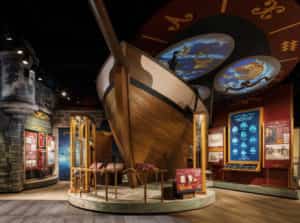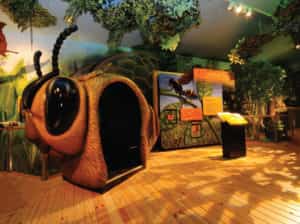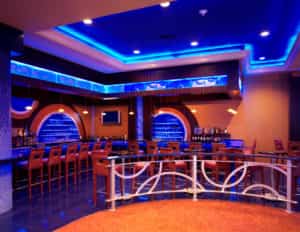Create
Roger Bargainer’s Creative Arts: ‘Everything we do tells a story’

Inside the cavernous back room of Creative Arts Unlimited, an otherwise nondescript Pinellas Park warehouse with a 25-foot ceiling, creative director Roger Barganier is leading a walking tour of jigsaw puzzle pieces – cut, lathed and polished wood, all shapes and sizes, stacked up neatly down each side of the corridor. Some are as tall as the building itself.
Here, Barganier indicates, are segments-in-progress of what will soon be some of the bay area’s most visited hotspots: The J.C. Newman Cigar Factory in Ybor City (among other things, they’re building a customized, walk-in humidor), the new exhibit for Winter the dolphin at the Clearwater Marine Aquarium, sconces, doorways, an art deco bar and façade pieces for St. Pete’s re-imagined State Theatre, fully articulated sections of the interior of Teaki, one of the new restaurants going up at the St. Pete Pier.

“Treasure Seekers: Pirates, Conquistadors and Shipwrecks,” conceived, built and installed for the Tampa Bay History Museum.
If you can dream it, Barganier likes to say, his company can make it. Creative Arts’ work is in museums, libraries, hospitals, retail and restaurants, theme parks and corporate centers all over the world. It’s a full-service firm – design, build and installation of public spaces. Conceptual spatial design.
The company has 25 full-time employees, from designers – art school graduate-types, hunched over computers and drafting tables in the upstairs offices – to the skilled fabricators, woodworkers and finishers on the workshop floor.
“We have a great collection of cabinet builders and woodworkers here, because they don’t want to build boxes and normal things,” Barganier says gleefully. “They’re only here because they get to make weird stuff every day. That’s the draw.”
Every project starts with Barganier, a 59-year old native of Mobile, Alabama, trained as an illustrator at the Ringling School of Design in Sarasota.

R.M.S. Titanic Grand Staircase, for the Titanic Museum in Pigeon Forge, Tennessee.
Spatial design, or “experiential design,” as it’s known in the business, is all about telling a story, he says.
“When you’re a book illustrator, your read the script, use your imagination, make your image. We do the same thing. The environment is our book.
“So everything we do that’s a visual tells a story – it may be a sculpture, it may be woodworking, or a painting or something else … and it’s not just graphics, it’s motion design, it’s digital maps, it’s holograms. The best thing that you can do is get this seamless environment that’s all about your vision, and all about that story.”
And for 20-plus years, some of the most compelling three-dimensional spatial storytelling has come out of this boxy green building three blocks west of U.S. 19.
“We have a setup here where we can create all those pieces for that story,” says Barganier. “We’ve got a very wide range of skills, so within that we’re not just one flavor. We can put many flavors into that space, telling that story.”

Interactive exhibit for the Daggerwing Nature Center, Boca Raton, Florida.
Before the Grand Staircase crafted for the Titanic Museum in Tennessee, before the holographic shipboard pirates at the Tampa Bay History Center, before the countless number of nature center exhibits, themed restaurants and hospital education centers, there was Maas Brothers.
After his 1985 graduation from Ringling, Barganier – who’d been a professional artist even before he went to the creative college – was snapped up by the Florida department store chain (more than 40 stores statewide) to create its visual merchandising. “That’s when they did fun sales promotions,” he recalls. “I’d do Valentine’s Day, Halloween and Christmas, and have all kind of manufacturing and collateral done.”
Dreaming up and fabricating “themed environments” wasn’t exactly what he had in mind when he first took up the brush and the pencil, but Barganier found that he liked the work. “Nobody that I know in the art field starts out wanting to do what they wind up doing,” he explains. “That’s not how it works. With retail, once you got in the door and you saw it, then you saw all the potential for it.
“I liked to sell things, I liked the drama and theatrics of a retail setting, I liked the corporate-ness of it. I have never not worked on major national accounts, from the time I was 22 years old.”

LUNA Restaurant and Lounge, Hilton Hotel, Carillon Park, St. Petersburg.
In the 1980s and early ‘90s, he stresses, “it was a different world. This was all pre-internet. They had big, glamourous department stores – every city had its retail palace. And when I talk to my 22-year-olds here (at Creative Arts), they have no clue what any of that was. If you don’t have it, you don’t miss it.”
When his employers (strongly) suggested he leave his home in St. Petersburg to be closer to their South Florida headquarters, Bargainer – married with a child on the way – balked.
Instead, he became art director for the St. Pete-based Creative Foam Designs, with whom he’d often contracted for custom shapes and pieces. Creative design, he explains, was no longer the domain of department stores and theme restaurants. Museums, theme parks, corporate designers, even retailers went to each other’s trade shows and exchanged ideas. The lines between design “types” were blurring and merging.
He designed and built the retail stores adjacent to Walt Disney World rides, then did some work at the park’s resorts. Universal Studios sought him out next, for movie launch events. And this led to work in New York, California and elsewhere.

Exploratorium, Wolfson Children’s Hospital, Jacksonville, Florida.
“I had learned, over seven years, to apply what I know to the country – that was department stores. And that went into theme parks, then into museums, and it spread out after that.”
In 1993, Creative Foam Designs became Creative Arts Unlimited. Barganier is creative director and president (he says his business partner, Chuck Stanmore, is the “left brain” of the operation).
As an artist, Bargainer says, the starting point for any job Creative Arts is hired to do remains the same: “It’s just like going back to the illustrator thing: What tells the story best? That’s why you choose what you choose. We’ve got a very wide palette.
“So when the client comes in, you listen, and they’ll tell you everything you need to know. Even though they don’t know they know it. When they describe who their audience is, who the visitor is, all that determines what it looks like.”
Kevin Chadwick bought St. Petersburg’s historic-but-crumbling State Theatre in 2018, and immediately set out to locate a designer who could bring what he envisioned – a stylish, art deco theater – to fruition.
“We were doing our research and found this company, Creative Arts,” Chadwick recalls. “Had no idea that they were right here in Pinellas Park. We were looking at some projects they had done in New York, and Washington, D.C. I said ‘That’s the quality of work I’m looking for – let’s look them up and see where we can find them.’”
Chadwick was stunned, he explains, to discover that Creative Arts was literally in his own back yard. He reached out to Roger Bargainer.
“He may be one of the most creative guys I’ve ever met,” Chadwick says. “He walked through it and immediately started visualizing what it could look like. I told him I really wanted to do an authentic art deco theater that will stand the test of time. And he graciously said ‘I’m in. I get it, let’s do it.’”
Bargainer, too, is enthused about the State Theatre project, which could – no promises – be ready for a late-spring unveiling.
“It was never like an opulent, old art deco theater, ever,” he says. “I think this is going to be more in the realm of the niceness of the Tampa Theatre, but for St. Petersburg.”
In a section of the big warehouse, he points to a palette of ornate wooden sconces, cut and polished into shapes that suggest an old-time, Hollywood-style nightclub. They have yet to be stained, painted or embellished in any way.
“There’s a lot of nice stained dark wood art deco-type shapes in the new State Theatre,” he explains. “Their accent pieces, like the bar and the sconces, are very much in the traditional, classic art deco motif – but not overpowering. Not as ornate as Tampa. But you don’t need that. It’s a lot cleaner.”







